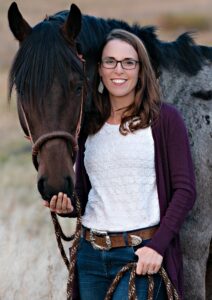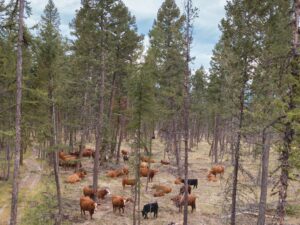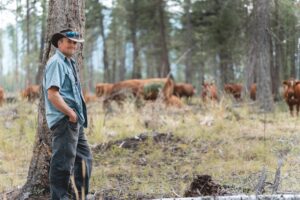Opinion Leader: "Smokey” the steer: The surprising role of cattle in community fire safety
By Amie Peck
Amie Peck, Stakeholder Engagement Manager at the Canadian Cattle Association, manages a national initiative that works to build public trust in the way beef cattle are raised in Canada.
at the Canadian Cattle Association, manages a national initiative that works to build public trust in the way beef cattle are raised in Canada.
Keith Manders clearly remembers the night that wildfires raged close to his home. “My wife looked out the window at four a.m. and saw flames coming down the mountain,” he recalls. “You can imagine how we felt.”
Fortunately for the rancher from Summerland, B.C., their house was spared, as was most of the crown land that Keith uses seasonally to graze his cattle. The experience reinforced what he and other local ranchers had known for years — that cattle can be used to influence wildfire behaviour.
Recent record wildfire seasons in British Columbia have seen up to three times more carbon dioxide released into the atmosphere than from all the province’s fossil fuel-burning sources combined. Frequent, catastrophic fire events have transformed B.C. forests — once a carbon sink — into a carbon source, turning the climate change flywheel even faster.
As the occurrence and magnitude of wildfires have grown, so too has the human and economic toll. Mitigation tools have become especially important to protect lives and homes in high-risk areas like Kelowna and Cranbrook.
After witnessing firsthand how grazing can impact fire behaviour, municipalities, researchers, and ranchers came together to collaborate on a series of pilot projects in B.C.
“I brought the local fire chief up here and he couldn’t believe it,” says Manders. “He saw the effectiveness of what we can do when cattle graze the pastures.”
On crown land and areas surrounding communities, tree stands are thinned to reduce the risk of large wildfire events. But with fewer trees, more sunlight and water reach the forest floor, increasing the abundance of grasses and shrubs. Known as fine fuels, dry grasses and shrubs are a volatile and easily ignited source for fires. Annual growth of grasses and shrubs without any removal will accumulate the fine fuel load and increase the potential wildfire intensity over time.
“Dried grass is a volatile fuel type and can have a dramatic effect on wildfire spread and severity," explains Shawna LaRade, professional agrologist and range officer with the Government of British Columbia. "Grazing is a safe, economical way to potentially reduce the intensity of wildfires by decreasing the fuel load.”
B.C. government invested in research pilot projects
After the extreme wildfire years of 2017 and 2018, which each saw more than 12,000 kilometres of forests and lands burn, the Government of B.C. approached the provincial cattle association to organize pilot projects.
The government contributed $500,000 in 2019 to help launch pilot projects on the outskirts of Kelowna, Summerland, Peachland and Cranbrook. The aim was to research the effectiveness of grazing cattle in forested areas surrounding at-risk communities. (Below, photo by Columbia Basin Trust)
 Creating innovative solutions to manage wildfire risk in these interfaces are especially important to preserve lives, homes and infrastructure where other methods, like prescribed burns, are not feasible. Although fine fuel reduction is the primary objective of the initiative, other objectives include maintaining important values such as wildlife habitat, biodiversity, and ecological integrity.
Creating innovative solutions to manage wildfire risk in these interfaces are especially important to preserve lives, homes and infrastructure where other methods, like prescribed burns, are not feasible. Although fine fuel reduction is the primary objective of the initiative, other objectives include maintaining important values such as wildlife habitat, biodiversity, and ecological integrity.
That is exactly where local ranchers saw the natural fit — grass feeds fire, but it also feeds cattle. Under the right conditions, fine fuels can contribute to what is known as a rolling crown fire – an out-of-control event that is impossible to manage. By removing a certain percentage of shrubs and grasses, grazing can successfully turn, slow and even stop fires.
When fires do happen, the goal is to lower their intensity so that resources can be deployed and be successful. By removing a proportion of grass during the growing season, the risk is reduced.
“We’re not saying targeted grazing is going to prevent a forest fire,” said Kevin Boon, General Manager of the British Columbia Cattle Association. “What we’re saying is that it will reduce the risk of a fire starting and, if one does start, it will give us the opportunity to manage the fire and bring it under control.”
With targeted grazing, cattle move into wildland areas adjacent to at-risk communities for two to three weeks in the spring or summer when grass is growing. This type of intense, short-term grazing mimics the natural disturbance of traditional grazers with which the land evolved. The grazed area provides the landscape level fuel break needed to provide the maximum benefit for both communities and infrastructure.
Providing a “win-win” for communities
For the farmers and ranchers involved, keeping cattle in wildland areas requires extra management, but also provides the chance to demonstrate the contribution they can make to their communities, above and beyond local food production. Several other areas in B.C. are exploring adding targeted grazing to their suite of wildfire mitigation tools.
 Jordy Thibeault, (At left, photo by Columbia Basin Trust) a local rancher from just outside Cranbrook, is happy to participate in the community's pilot project. Each spring, for a few weeks, he brings his herd of cattle to graze the crown land bordering the town. The cows reduce the amount of fuel available, but they also improve the health of the remaining grass.
Jordy Thibeault, (At left, photo by Columbia Basin Trust) a local rancher from just outside Cranbrook, is happy to participate in the community's pilot project. Each spring, for a few weeks, he brings his herd of cattle to graze the crown land bordering the town. The cows reduce the amount of fuel available, but they also improve the health of the remaining grass.
“They utilize the grass for a shorter period of time and then the land is left to rest,” Thibeault says. “The grass stays greener in a vegetative state longer, meaning it’s less likely to burn.”
To Thibeault, it is a win-win situation. “We definitely have a role in protecting the community,” he says. “If you came in here with a machine, like a lawnmower, all it would be is a cost-output. We have a tool that can remove this fire danger while producing food to feed the community and add benefit to society.”
Interested in learning more? Watch a short documentary on three communities in British Columbia using cattle in their fire management strategies.
R$
| Organizations: | |
| People: | |
| Topics: |
Events For Leaders in
Science, Tech, Innovation, and Policy
Discuss and learn from those in the know at our virtual and in-person events.
See Upcoming Events
You have 0 free articles remaining.
Don't miss out - start your free trial today.
Start your FREE trial Already a member? Log in
By using this website, you agree to our use of cookies. We use cookies to provide you with a great experience and to help our website run effectively in accordance with our Privacy Policy and Terms of Service.




